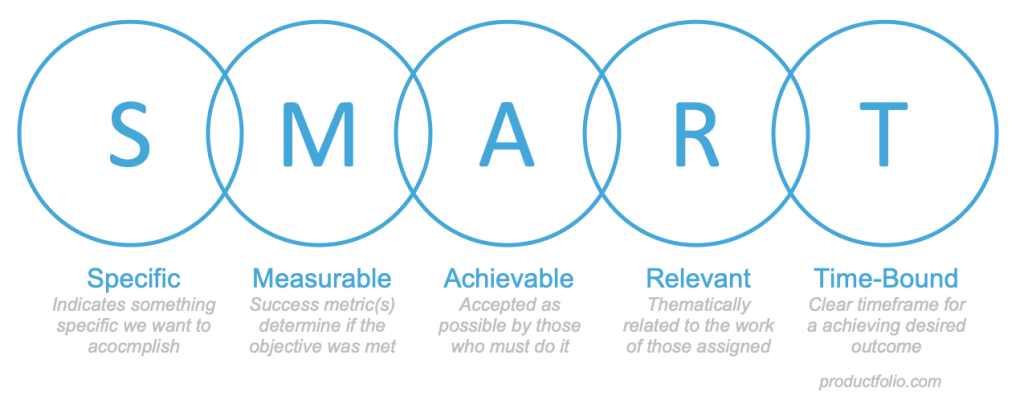What are SMART Objectives?
Have you ever felt like you’re running in place like a hamster on a wheel? Setting objectives means that you can clarify your goals and focus your efforts on achievable milestones. SMART Objectives help you to use your time and energy productively so that you can stay focused on your objectives and achieve your goals. They help you to get off of the hamster wheel into a productive workflow.
Objectives differentiate from goals when creating a strategy for an organization. A goal is a higher level outcome, whereas an objective is a more specific outcome, stated in response to the goal. Higher-level business strategy may have goals as outputs for the organization, while Product Managers set objectives for achieving these goals. A Product Manager should conform to SMART principles for the objectives to be effective.

S – Specific
Be as specific as possible when setting your goal, the more specific the better. It often helps to break it down into the “W” questions:
- Who – Who is involved and who will this benefit
- What – What are you trying to accomplish by setting this goal
- When – When would you like to complete this goal
- Where – Where will this goal take place
- Why – Why is this goal important
- Which – Which resources will be needed to accomplish this goal
M – Measurable
It’s important that your objectives be measurable so that you can stay on track, stay focused and feel a sense of accomplishment as you move closer to your goal. Setting milestones with small achievable wins helps to make a goal feel more tangible.
A – Attainable
Your goal needs to be realistic and attainable. It’s important to determine if your goal is achievable based on things like time-frame, costs, and skillset.
R – Relevant
This stage in setting relevant objectives is about making sure that your goal is well-timed in the marketplace. Ask questions like, is this the right time to be launching this product? Also, make sure that the goal is in alignment with the company’s overall purpose.
T – Time-Bound
Deadlines are important to help keep things on track. Realistic, attainable deadlines are even more important. If a deadline is unrealistic it increases the chances of overall project failure. It’s helpful to define what has been achieved during the small measurable goals to keep the momentum.
The acronym S.M.A.R.T. refers to both S.M.A.R.T. objectives as well as S.M.A.R.T. goals. While the acronym is the same the overall meaning differs slightly. Goals are the specific outcome that is being defined, and objectives refer to the determined steps that will be implemented to direct the completion of a project.
It helps to write out your objectives, or type them up onto a chart so that you and your team have a visual chart that illustrates the progress everyone is making. It’s also important to keep in mind that a long term goal may change over time, therefore the objectives will change. Companies change their objectives, the market changes and new technologies emerge. For this reason, you may be tasked with writing a SMARTER Objective. A SMARTER Objective adds ER to the acronym, with E standing for evaluate and R standing for Re-do. It’s not uncommon to re-evaluate long term objectives to match the current market.
Advantages and Disadvantages
SMART is a great tool to use to clarify your objectives, create focus and keep the team motivated and on track to achieve the overall goal. Some of the drawbacks of SMART is that it isn’t very flexible, and can be seen as rigid. It has also been criticized for lacking creativity. The five steps also don’t have a place for feedback from the team as you progress through the stages.
SMART is a great five-step guide for clear and simplified objective and goal planning and works well if you’re looking for a minimalist straightforward approach to creating objectives for your next product.


